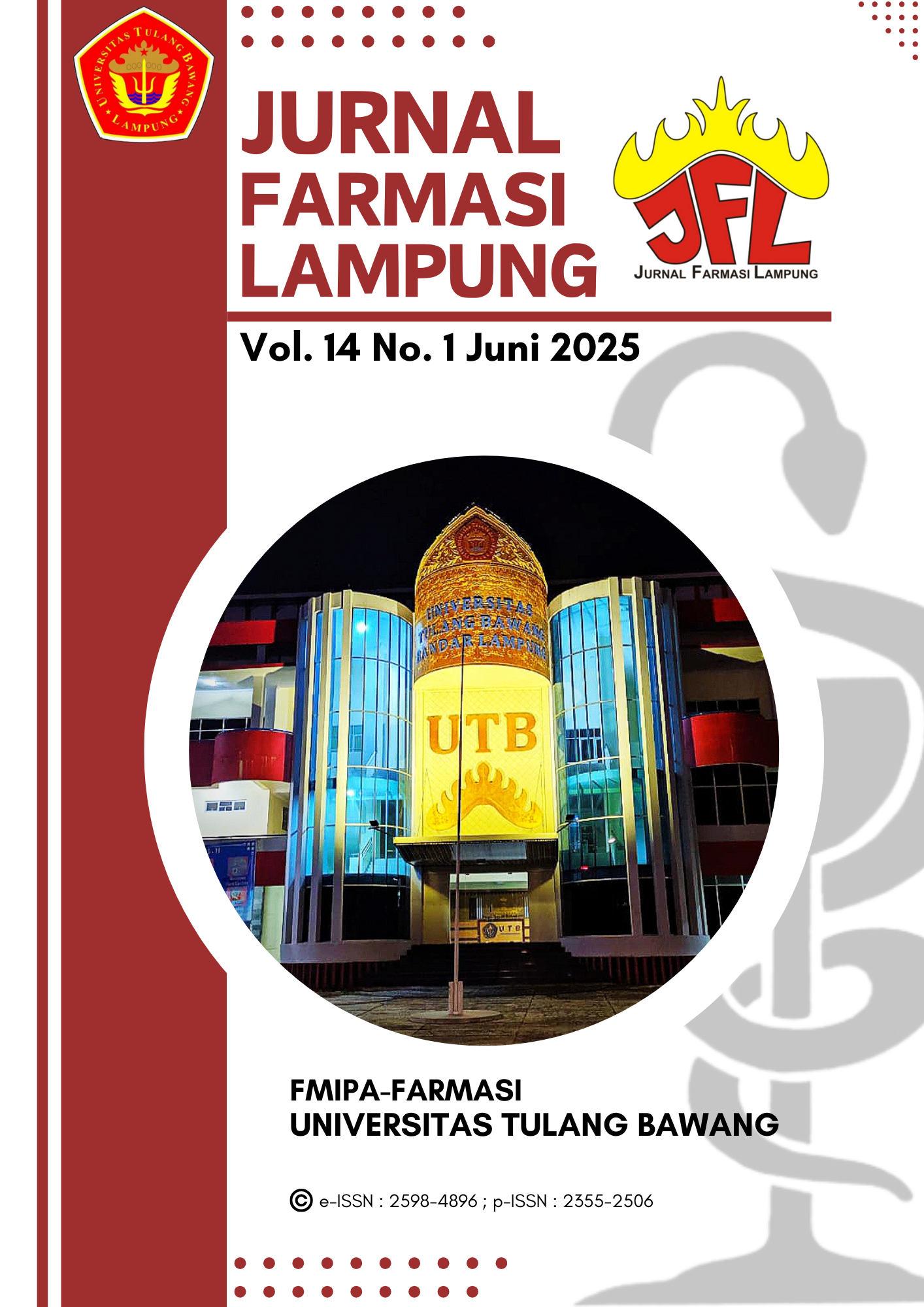STUDI IN SILICO QUININ SEBAGAI KANDIDAT AGEN ANTI-AGING
IN SILICO STUDY OF QUININE AS A CANDIDATE ANTI-AGING AGENT
DOI:
https://doi.org/10.37090/jfl.v14i1.2399Abstract
Aging is a complex natural process and an inherent part of the life cycle. The continuous aging and accumulation of cells contribute to the degradation of the extracellular matrix, which further accelerates the aging process. Various topical agents have been utilized to combat aging, primarily through anti-aging treatments. Examples include the use of topical agents such as retinoids (retinol), vitamin C, hyaluronic acid, alpha hydroxy acids (AHA), and beta hydroxy acids (BHA). This study aims to explore the potential anti-aging properties of compounds found in the quinine-producing plants Cinchona ledgeriana (Ledger) and Cinchona succirubra (Succi) through a molecular approach using the molecular docking method to assess their activity against aging-related proteins. The tested ligands in this study include quinine, cinchonine, quinidine, and cinchonidine, with retinol as the antagonist ligand. In silico analysis suggests that quinine, cinchonine, quinidine, and cinchonidine from Cinchona ledgeriana (Ledger) and Cinchona succirubra (Succi) exhibit strong potential as anti-aging agents by targeting the proteins hyaluronidase receptor (1FCV), elastase (1Y93), collagenase (2D1N), tyrosinase (2Y9X), and HSP90 (5XRB). Molecular docking simulations using MOE 2015.10 revealed quinine's superior binding affinity, with free energy values ranging from -4.9 to -6.8 kcal/mol across target proteins. Critical interactions with His263 (tyrosinase) and Asp206 (elastase)were identified through LigPlot analysis. The docking analysis confirmed the reliability of the methodology, demonstrating that quinine, quinidine, cinchonine, and cinchonidine strongly bind to key skin-ageing enzymes. This study demonstrates the potential of Cinchona bark-derived phytochemicals as anti-aging agents, with quinine exhibiting superior inhibitory activity against tyrosinase. Quinine demonstrated the strongest inhibition against tyrosinase (ΔG = -6.84 kcal/mol), outperforming reference ligands and other Cinchona alkaloids. These findings provide a scientific basis for further exploration of these compounds in mitigating skin aging and enhancing dermatological health. Keywords: Antiaging, in silico, molecular docking, quinineDownloads
References
[1] Shin, S.H., Lee, Y.H., Rho, N.-K., dan Park, K.Y. (2023). Skin aging from mechanisms to interventions: focusing on dermal aging. Frontiers in Physiology, 14: 1195272.
[2] Lee, H., Hong, Y., dan Kim, M. (2021). Structural and Functional Changes and Possible Molecular Mechanisms in Aged Skin. International Journal of Molecular Sciences, 22: 12489.
[3] Cheng, G.-G., Cai, X.-H., Zhang, B.-H., Li, Y., Gu, J., Bao, M.-F., dkk. (2014). Cinchona Alkaloids from Cinchona succirubra and Cinchona ledgeriana. Planta Medica, 80: 223–230.
[4] Gurung, P. & De, P. (2022). Spectrum of biological properties of cinchona alkaloids: A brief review.
[5] Lang, F., Gulbins, E., Lerche, H., Huber, S. M., Kempe, D. S., & Föller, M. (2017). Stimulation of Erythrocyte Cell Membrane Scrambling by Quinine. Cellular Physiology and Biochemistry, 40(3-4), 657–668. https://doi.org/10.1159/000453144.
[6] Malau, N.D. dan Sianturi, M. (2017). Molecular Dynamics Approach in Designing Thermostable Aspergillus niger Xylanase. IOP Conference Series: Earth and Environmental Science, 58: 012063.
[7] Chemical Computing Group. (2024). Molecular Operating Environment (MOE). Retrieved from https://www.chemcomp.com/Products.htm.
[8] Morris, G. M., Huey, R., Lindstrom, W., Sanner, M. F., Belew, R. K., Goodsell, D. S., & Olson, A. J. (2011). Molecular docking: A powerful approach for structure-based drug discovery. Current Computer-Aided Drug Design, 7(2), 146-157. https://doi.org/10.2174/157340911795677602.
[9] Pagadala, N. S., Syed, K., & Tuszynski, J. (2017). Software for molecular docking: a review. Biophysical Reviews, 9(2), 91. https://www.ncbi.nlm.nih.gov/pmc/articles/PMC5425816/.
[10] Wang, R., Fang, X., Lu, Y., & Wang, S. (2016). Comprehensive evaluation of ten docking programs on a diverse set of protein-ligand complexes: The prediction accuracy of sampling power and scoring power. Physical Chemistry Chemical Physics, 18(18), 12964-12975. https://doi.org/10.1039/C6CP01555G.
[11] Sousa, S. F., Ribeiro, A. J., Coimbra, J. T., Neves, R. P., Martins, S. A., Moorthy, N. S., Fernandes, P. A., & Ramos, M. J. (2013). Protein-Ligand Docking in the New Millennium – A Retrospective of 10 Years in the Field. Current Medicinal Chemistry, 20(18), 2296–2314. https://doi.org/10.2174/0929867311320180002.
[12] WebGRO for Macromolecular Simulations. (2025). Retrieved from https://simlab.uams.edu/.
[13] Jones, G., Willett, P., Glen, R. C., Leach, A. R., & Taylor, R. (1997). Development and validation of a genetic algorithm for flexible docking. Journal of Molecular Biology, 267(3), 727–748. https://doi.org/10.1006/jmbi.1996.0897.
[14] Wang, R., Lai, L., & Wang, S. (2016). Further development and validation of empirical scoring functions for structure-based binding affinity prediction. Journal of Computer-Aided Molecular Design, 16(1), 11–26. https://doi.org/10.1023/A:1016357811882.
[15] Hostettmann, K., Marston, A., Ndjoko, K., & Wolfender, J. L. (2018). Quantitative determination of major alkaloids in Cinchona bark by chromatographic methods. Phytochemistry Reviews. PMC6193530.









